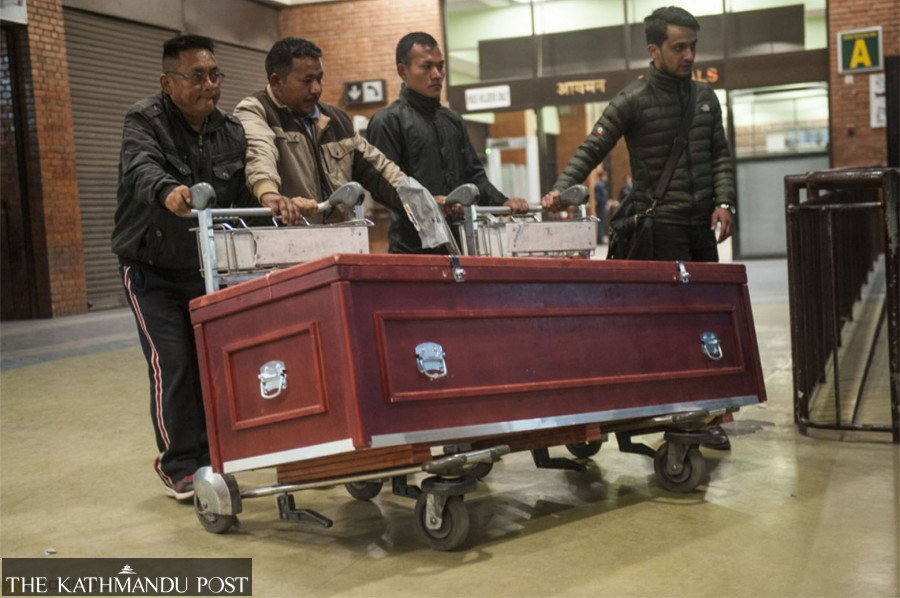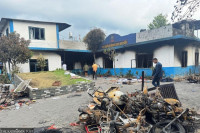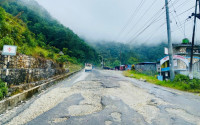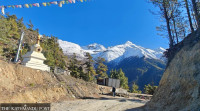Gandaki Province
Concerns mount over rising Nepali migrant deaths
Around 15 Nepali workers die abroad each month. Reports says 95 migrants from Gandaki Province died abroad in the first six months of this fiscal year.
Pratiksha Kafle
The number of Nepali migrant workers from Gandaki Province dying on foreign shores has reached concerning levels, as shown by the data released by the Safer Migration Project (SaMI), a bilateral initiative of the governments of Nepal and Switzerland.
According to the data of the initiative, a total of 95 migrant workers from Gandaki Province died in various labour destinations in the first six months of the fiscal year 2023-24 starting July 17. Syangja district tops the list with 19 deaths followed by Nawalparasi East with 17.
Shiva Regmi, programme officer at the SaMI, said an even higher number of migrant workers return home maimed, injured or sick every month. “The data shows that on average 15 workers die every month in various countries. The figure is quite alarming,” said Regmi.
Hem Bahadur Bishwakarma, aged 38, of ward 13 of Pokhara Metropolitan City went to Saudi Arabia a few years ago to secure a safe future for his wife, three daughters and a son. But on September 19, 2023, the family he had left behind received news of his death. The bereaved family had to wait for around a month to bring his body home.
Thousands of youths from all 11 districts of Gandaki are abroad now under foreign employment. Scores of migrant workers die annually, raising questions about the safety of the workers abroad.
The bereaved families face inexpressible pains and suffering to bring the deceased workers home. Of the total 95 deaths recorded in the first six months of the current fiscal year of 2023-24, only 44 bodies have been repatriated so far. “Bodies of some workers who died in Malaysia, United Arab Emirates, Saudi Arabia, Oman and Qatar are yet to be brought home,” said Regmi.
Thirty-year-old Suraj Sarki, a permanent resident of ward 13 of Pokhara Metropolitan City, died in Dubai, United Arab Emirates in this fiscal year. Sarki, who worked as a security guard in a Dubai-based company, reportedly died of a heart attack. As many as 61 workers, according to SaMI, died in the past two months alone.
The number of migrant deaths has risen significantly in the past few years. According to the Department of Foreign Employment, a total of 680 Nepali migrant workers died in the fiscal year 2019-20 while the figure stood at 1,275 in 2020-21. Similarly, 1,509 and 1,208 migrant workers from across the country died in the fiscal years 2021-22 and 2022-23, respectively.
While the families of migrant workers who go abroad through proper channels receive the news of the death of their loved ones through official mediums and also receive help in bringing the dead bodies back home, the families of scores of Nepalis who go to the Gulf countries through illegal channels without obtaining labour permits have to face uncertainties about the fate of their loved ones abroad.
“Many foreign job aspirants are unaware of health or life insurance benefits. They are easily duped by the employers or the manpower agents who take advantage of their ignorance,” said Rajani Pariyar who is active for the rights and safety of the migrant workers. “Some migrant workers stay in their host countries illegally once their labour permit expires. It is difficult to trace the death of such migrant workers.”
According to Pariyar, the families of the workers who die abroad are often cheated by agents when it comes to receiving compensation for the death of their family members. “The bereaved families are further victimised as the middlemen swindle the relief amount,” she added. “Foreign job aspirants must be provided with orientation training and basic skills training about the work they are hired to do. They also must be aware of their rights in their host countries.”
The number of countries open officially for foreign employment for Nepali workers is 111. The workers are prevented from going to some countries like Afghanistan, Libya and Iraq for employment. However, several Nepali workers go to these destinations illegally looking for jobs.
It is not only men who leave the country to go abroad for foreign employment. According to the data of the Department of Foreign Employment, of the total migrant workers from Gandaki Province around 10 percent are women. A total of 99,803 people got labour permits in Gandaki Province in the last fiscal year 2022-23. Among them, 8,357 were women.
Suchita Tamang of ward 13 of Pokhara returned home a few months ago after working for four and half years in Kuwait. “Nepali workers have to face various problems due to lack of skills and basic information regarding foreign employment,” said Tamang. “All foreign job aspirants must undergo at least the basic level of skills training and must have enough information to make informed choices before going abroad.”




 10.12°C Kathmandu
10.12°C Kathmandu.jpg)










